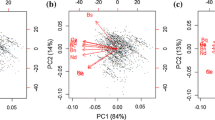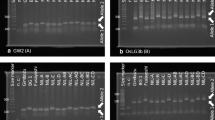Abstract
The study of the phenotypic responses of a set of genotypes in their dependence on the environment has always been an important area of research in plant breeding. Non-parallelism of those responses is called genotype by environment interaction (GEI). GEI especially affects plant breeding strategies, when the phenotypic superiority of genotypes changes in relation to the environment. The study of the genetic basis of GEI involves the modelling of quantitative trait locus (QTL) expression in its dependence on environmental factors. We present a modelling framework for studying the interaction between QTL and environment, using regression models in a mixed model context. We integrate regression models for QTL main effect expression with factorial regression models for genotype by environment interaction, and, in addition, take care to model adequately the residual genetic variation. Factorial regression models describe GEI as differential genotypic sensitivity to one or more environmental covariables. We show how factorial regression models can be generalized to make also QTL expression dependent on environmental covariables. As an illustrative example, we reanalyzed yield data from the North American Barley Genome Project. QTL by environment interaction for yield, as identified at the 2H chromosome could be described as QTL expression in relation to the magnitude of the temperature range during heading.
Similar content being viewed by others
References
Benjamini, Y. & Y. Hochberg, 1995. Controlling the false discovery rate: A practical and powerful approach to multiple testing. J R Statist Soc B 57: 289–300.
Caliński, T., Z. Kaczmarek, P. Krajewski, C. Frova & M. Sari-Gorla, 2000. Amultivariate approach to the problem of QTL localization. Heredity 84: 303–310.
Cooper, M. & G.L. Hammer (Eds.), 1996. Plant adaptation and crop improvement, 636 pp. CAB International, Oxon, U.K.
Crossa, J. & P. Cornelius, 2002. Linear–bilinear models for the analysis of genotype–environment interaction. In: M.S. Kang (Ed.), Quantitative Genetics, Genomics and Plant Breeding, pp. 305-322. CAB International, Wallingford.
Denis, J.-B., H.-P. Piepho & F.A. van Eeuwijk, 1997. Modelling expectation and variance for genotype by environment data. Heredity 79: 162–171.
Hackett, C.A., R.C. Meyer & W.T.B. Thomas, 2001. Multi-trait QTL mapping in barley using multivariate regression. Genet Res 77: 95–106.
Haley, C.S. & S.A. Knott, 1992. Asimple regression method for mapping quantitative trait loci in line crosses using flanking markers. Heredity 69: 315–324.
Hargreaves, G.H. & Z.A. Samani, 1982. Estimating potential evapotranspiration. Technical note. J Irrig Drainage 108: 225–230.
Hayes, P.M., B.H. Liu, S.J. Knapp, F. Chen, B. Jones, T. Blake, J. Franckowiak, D. Rasmusson, M. Sorrells, S.E. Ullrich, D. Wesenberg & A. Kleinhofs, 1993. Quantitative trait locus effects and environmental interaction in a sample of North American barley germplasm. Theor Appl Genet 87: 392–401.
Jansen, R.C., J.W. Van Ooijen, P. Stam, C. Lister & C. Dean, 1995. Genotype-by–environment interaction in genetic mapping of multiple quantitative trait loci. Theor Appl Genet 91: 33–37.
Jiang, C. & Z.B. Zeng, 1995. Multiple trait analysis of genetic mapping for quantitative trait loci. Genetics 140: 1111–1127.
Jiang, C. & Z.B. Zeng, 1997. Mapping quantitative trait loci with dominant and missing markers in various crosses from two inbred lines. Genetica 101: 47–58.
Kang, M.S. & H.G. Gauch Jr. (Eds.), 1996. Genotype-by-environment interaction, 416 pp. CRS Press Inc. Boca Raton, Florida.
Korol, A.B., Y.I. Ronin & E. Nevo, 1998. Approximate analysis of QTL–environment interaction with no limits on the number of environments. Genetics 148: 2015–2028.
Lin, C.S., M.R. Binns & L.P. Lefkovitch, 1986. Stability analysis: Where do we stand? Crop Sci 26: 894–900.
Lynch, M. & B. Walsh, 1998. Genetics and analysis of quantitative traits. Sinauer Associates, Suderland, Massachusetts.
Piepho, H.P., 1997. Analyzing genotype–environment data by mixed models with multiplicative effects. Biometrics 53: 761–766.
Piepho, H.P., 2000. Amixed-model approach to mapping quantitative trait loci in barley on the basis of multiple environment data. Genetics 156: 2043–2050.
Romagosa, I., F. Han, S.E. Ullrich, P.M. Hayes, and D.M. Wesenberg, 1999. Verification of yield QTL through realized molecular marker assisted selection responses in a barley cross. Mol Breed 5: 143–152.
Romagosa I., S.E. Ullrich, F. Han & P.M. Hayes, 1996. Use of the AMMI model in QTL mapping for adaptation in barley. Theor Appl Genet 93: 30–37.
Sari-Gorla, M., T. Calinski, Z. Kaczmarek & P. Krajewski, 1997. Detection of QTL ×environment interaction in maize by a least squares interval mapping method. Heredity 78: 146–157.
SAS, 1999. SAS/STAT User's Guide. SAS Institute, Cary, NC.
Smith, A.B., 1999. Multiplicative mixed models for the analysis of multi-environment trial data. Ph.D. thesis, Dpt. of Statistics, The University of Adelaide, Adelaide, South Australia.
Smith, A., B. Cullis & R. Thompson, 2001. Analyzing variety by en-vironment data using multiplicative mixed models and adjustment for spatial field trend. Biometrics 57: 1138–1147.
Van Eeuwijk, F.A., M. Cooper, I.H. DeLacy, S. Ceccarelli & S. Grando, 2001. Some vocabulary and grammar for the analysis of multi-environment trials, as applied to the analysis of FPB and PPB trials. Euphytica 122: 477–490.
Van Eeuwijk F.A., J. Crossa, M. Vargas & J.M. Ribaut, 2002. Analysing QTL by environment interaction by factorial regression, with an application to the CIMMYT drought and low nitrogen stress programme in maize. In: M.S. Kang (Ed.), Quantitative Genetics, Genomics and Plant Breeding, pp. 245–256. CAB International, Wallingford.
Van Eeuwijk, F.A., J.B. Denis, and M.S. Kang, 1996. Incorporating additional information on genotypes and environments in models for two-way genotype by environment tables. In: M.S. Kang & H.G. Gauch (Eds.), Genotype-by-Environment Interaction, pp. 15–50. CRC Press, Boca Raton.
Verbeke, G. & G. Molenberghs, 2000. Linear Mixed Models for Longitudinal Data. Springer, New York.
Verbyla, A.P., P.J. Eckermann, R. Thompson & B. Cullis, 2003. The analysis of quantitative trait loci in multi-environment trials using a multiplicative mixed model. Aust J Agric Res 54: (in press).
Voltas, J., F.A. van Eeuwijk, A. Sombrero, A. Lafarga, E. Igartua & I. Romagosa, 1999a. Integrating statistical and ecophysiological analyses of genotype by environment interaction for grain filling of barley. I. Individual grain weight. Field Crop Res 62: 63–74.
Voltas, J., F.A. van Eeuwijk, J.L. Araus & I. Romagosa, 1999b. Integrating statistical and ecophysiological analyses of genotype by environment interaction for grain filling of barley. II. Grain growth. Field Crop Res 62: 75–84.
Zadocks, J.C., T.T. Chang & C.F. Konzak, 1974. A decimal code for the growth stages of cereals. Weed Res 14: 415–421.
Author information
Authors and Affiliations
Rights and permissions
About this article
Cite this article
Malosetti, M., Voltas, J., Romagosa, I. et al. Mixed models including environmental covariables for studying QTL by environment interaction. Euphytica 137, 139–145 (2004). https://doi.org/10.1023/B:EUPH.0000040511.46388.ef
Issue Date:
DOI: https://doi.org/10.1023/B:EUPH.0000040511.46388.ef




